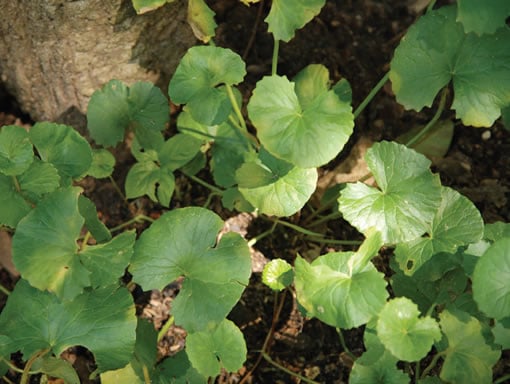Gotu kola

Gotu kola has been used in Asia for thousands of years, both as a medicine and as a leafy vegetable. It is first mentioned in the historic ‘Sushruta Samhita’, one of the earliest Ayurvedic medical texts compiled around 300 C.E. This luscious green herb is a favourite to help improve mindfulness and is said to revitalise consciousness and maintain youthful wit.
Gotu kola is a stimulant to the circulation with a particular focus on healthy skin. It contains some very interesting compounds called asiaticosides that have strong stimulatory effects on the circulation helping to develop the angiogenic process of developing blood vessels in the skin. This improves the rate of keratinisation of the skin, strengthening and protecting it as well as increasing collagen production and synthesis. It is an excellent herb for healing inflammation of connective tissue associated with chronic skin conditions and musculoskeletal damage.
Gotu kola improves circulation to the brain where it supports cognitive functioning such as memory and concentration whilst also protecting the brain tissue from oxidative damage. This has made gotu kola effective for conditions such as Alzheimers, stroke and degeneration influenced by ageing.
Gotu kola’s affinity for both the skin and the nervous system reflect its specific use in skin disorders caused by stress.
The plant
Gotu kola, or centella asiatica, is a small creeping herb that is native to Asia and naturalised in other parts of the world, including Africa and the US. It is a water-loving plant and is commonly found growing along streams, irrigation channels and in paddy fields. Pukka have often seen it growing in the boggy areas that accumulate around water pumps in Indian villages.
The plant has distinctive round leaves, often described as ‘brain-shaped’, which interestingly conforms with the ‘doctrine of signatures’ – an ancient belief that herbs resemble parts of the body that they are used to treat.
Origins of Pukka gotu kola
Over the years Pukka have sourced their gotu kola from Sri Lanka, India and Zimbabwe.
Sri Lanka has a very well established tradition of growing gotu kola; one of the reasons for this is that it is in high demand for one of Sri Lanka’s most popular, delicious and healthy dishes – the gotu kola sambol (a salad made of finely chopped gotu kola leaves, chilli and other spices). It is also because the plants thrive in Sri Lanka’s warm, humid climate, and can easily be grown in its ubiquitous flood-irrigated paddy fields.
Zimbabwe is less known for gotu kola cultivation. However Pukka have found that it produces excellent quality leaves with high levels of asiaticosides, the active ingredient that is associated with wound healing and the main indicator of the plants’ overall therapeutic properties.
Most of the gotu kola that comes from India is collected from the wild. From an ecological perspective this is not a problem as only the aerial parts are harvested and they regenerate quickly. However, from a quality perspective wild collection is a risk due to the number of contaminated water sources and its tendency to accumulate heavy metals. So over the years Pukka have put a lot of effort into working with their partners to bring it into cultivation to ensure that all of their gotu kola is cultivated on organic land and irrigated with pristine clean water.
Etymology
Gotu kola (Centella asiatica) is often confused with brahmi (bacopa monnieri), not because they look similar, but because in India they are both known as brahmi. Pukka belongs to the school of Ayurvedic thought that brahmi is bacopa monnieri, and not centella asiatica.
In Sanskrit gotu kola is known as mandukaparni, which translates as ‘frog-leaved’, referring to its leaf shape resembling the webbed-feet of a frog. The word ‘gotu kola’ itself comes from Sri Lanka, literally meaning ‘cone leaf’ in Sinhalese, presumably referring to its tendency to curl its leaves into a cone shape.
Interesting facts
In India gotu kola is sometimes referred to as ‘tiger herb’ due to the fact that wounded tigers roll themselves in gotu kola plants.
Apparently it is also eaten by elephants, which could explain their excellent memories.
A little bit of chemistry…
Gotu kola also has a relaxing effect on the central nervous system through increasing gamma-Aminobutyric acid (GABA) which provides relief from hyper anxious states, lowering corticosterone levels, enhancing memory and protecting the brain from degeneration. Constituents known as asiaticosides, specifically triterpenoid saponins, encourage collagen production, collagen synthesis and effective connective tissue repair. The asiaticosides improve capillary strength, wound-repair mechanisms and have an overall strengthening effect on connective and nervous tissues throughout the body. Gotu kola is packed with saponins which act as cleansing and softening agents for the skin. Oligosaccharides act as moisturisers, and phytosterols are protective agents.

